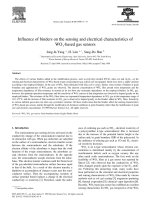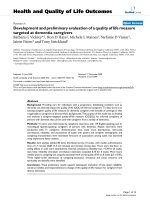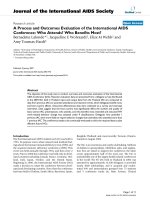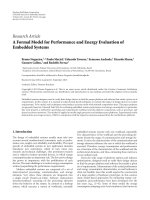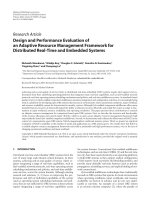Processing and quality evaluation of coconut based jam
Bạn đang xem bản rút gọn của tài liệu. Xem và tải ngay bản đầy đủ của tài liệu tại đây (149.8 KB, 5 trang )
IOSR Journal Of Environmental Science, Toxicology And Food Technology (IOSR-JESTFT)
e-ISSN: 2319-2402,p- ISSN: 2319-2399. Volume 8, Issue 1 Ver. I (Jan. 2014), PP 10-14
www.iosrjournals.org
Processing and quality evaluation of coconut based jam
G.Sindumathi1, S. Amutha2
1
(Post Harvest Technology Centre, Agricultural Engineering College and Research Institute, Tamil Nadu
Agricultural University, India)
2
(Department of Human Development, Home Science College and Research Institute, Tamil Nadu Agricultural
University, India)
Abstract : Coconut stand out as the foremost amongst the palms that human kind has discovered for is
multifarious uses to sustain and support life. In recent years emphasis is focused on product diversification, by
products utilization and development of value added coconut products to improve the coconut economy.
Coconut jam is a traditional high sugar coconut food product, commonly consumed as desert, bread spread and
rice cake topping. An attempt was made to utilize the residual coconut pulp left in the tender coconuts after
removal of coconut water. The coconut pulp was mixed with pineapple pulp and guava pulp in different
proportions to increase the acceptability of the jam. The prepared coconut jam packed in plastic container and
glass bottles and had the shelf life of 180 days at room and refrigerated temperatures. The changes in chemical,
microbial and organoleptic characteristics of the coconut jam were studied.
Keywords: Tender coconut, Pineapple, Jam, Glass bottles, plastic containers, Storage
I.
Introduction
Coconut palm (Cocos mucifera L) a member of the palmae family, is one of the economically
important trees in the world. The tree of coconut is called as Kalpatara, because all the parts of it are useful in
one form or the other. Coconuts and coconut oil have been eaten as a primary food for thousands of years by
millions of people in Asia, the Pacific islands, Africa and Central America. Several traditional foods containing
coconut products are being prepared and processed using newer processing techniques and tested for their
acceptability, quality and commercial viability (Kumar et al., 2007 [1]). As a functional food, coconut has fatty
acids that provide both energy and raw material for antimicrobial activity and monoglycerides. Lauric acid, the
major fatty acid present in coconut, has been recognized for its antiviral, antibacterial and antiprotozoal
functions. Young tender coconuts are widely consumed as fruit which consists of a soft white flesh and sweet
aromatic juice. Initially, the young coconut kernel contains more water. The flesh of the young coconut is an
aluminous endosperm which is white in colour, edible, soft and more jelly like. It is sweet to taste and is
relatively high in minerals such as iron, phosphorus and zinc. The residual pulp left after removal of water from
the kernels can be converted in to value added products such as jam.
Jam is a traditional high sugar coconut food product, commonly consumed as desert, bread spread, and
rice cake topping. It is as intermediate moisture food prepared by boiling fruit pulp pulp with sugar, pectin, acid
and other ingredients (preservatives, coloring and flavouring materials). It is light to dark brown in color, thick
get spreadable in consistency, with a rich creamy flavor. Jams can be prepared from single fruit or in
combination with two or more fruits. Tender coconuts are generally cut and the inside water is consumed as
such as a drink or used for the development of beverages. However, the food use of residual young coconut
kernel has not been explored much. Therefore, the present study was undertaken to utilize residual tender
coconut pulp for the development of jam product in combination with pine apple pulp and guava pulp with an
objective of increased palatability and sensory acceptability.
II.
Materials and Methods
2.1 Raw materials
Tender green coconuts and sound ripe pineapple and guava fruits were procured from the local market
of Madurai city, India. Green coconuts of around 8-9 months old and characterized by sweet juice with a
moderately thick pulp were selected for the present study. A sanitized stainless steel knife was used to cut a
small incision at the top of the nuts for the extraction of coconut water as well as to scope out the pulp.
Pineapples were washed and peeled and the crowns as well as eyes were removed followed by pulping using a
mixer. Fresh and riped guavas were cleaned, cutting into pieces and make into fine pulp using mixie.
2.2 Preparation of Jam
For the standardization of jam, Pectin rich fruits such as pineapple, guava were incorporated along with
tender coconut pulp in different ratios as given in Table 1
www.iosrjournals.org
10 | Page
Processing and quality evaluation of coconut based jam
Table 1. Development of Coconut based Jam
Ingredients
Tender coconut pulp
Pineapple pulp
Guava pulp
sugar
Citric acid
T1
100
75
0.5
T2
90
5
5
75
0.5
Level of incorporation (g)
T3
T4
80
70
10
15
10
15
75
75
0.5
0.5
T5
60
20
20
75
0.5
T6
50
25
25
75
0.5
The prepared jam was evaluated organoleptically and found that jam prepared from 50 per cent tender
coconut pulp 25 per cent pine apple pulp and 25 per cent guava pulp was highly acceptable.
2.3 Method of preparation
The mixture of tender coconut pulp, pineapple pulp and guava pulp in standardized proportion was
taken in an open stainless steel pan and a required amount of sugar was added and heated continuously on a gas
stove under low flame. When the total soluble solids (TSS) reached 60°bx, citric acid was added and the pulp
mixture was mixed thoroughly and stirred continuously using a steel ladle. Heating was stopped when the TSS
reached 67- 68°bx, and the mixture was hot filled into 300 ml previously sterilized glass bottles and plastic
container and cooled under ambient conditions. The jam prepared was stored at ambient and refrigerated
temperatures and away from light and analyzed over a period 6 months.
Fig.1 Flow chart for preparation of coconut based jam
Coconut pulp + guava pulp + pineapple pulp (50:25:25)
Addition of sugar (75g)
Cooking the pulp (slow cooking with occasional stirring for 15 min)
Addition of citric acid (0.5g)
Judging the end point (TSS 68°bx using refractometer)
Packing (filled the hot jam into clean, dry sterilized in glass bottles and plastic containers)
Cooling
Stored at room and refrigerated temperature
2.4 Physicochemical characteristics of Jam
Knowledge of the physico-chemical properties of food is fundamental in analyzing the characteristics
of food during its processing. The study of these food properties and their responses to process conditions are
necessary because they influence the treatment received during the processing and qualities of food
(Rao and Das, 2003 [2]). Total soluble soilds were measured using a hand refractometer (ERMA,Tokyo,Japan)
and expressed as degree Brix. The pH of samples was measured using microprocessor based digital pH meter
(Century Model CP931, Bangalore, India). The acidity of the sample was estimated by the (Ranganna, 1995[3])
the total and reducing sugar content of the sample was determined by the Shaffer Somogyi micro method
described by McDonald and Foley (1960[4]). Ascorbic acid was estimated following the procedure of
Mahadevan and Sridhar (1982 [5]). The ash contents of the jam were determined according to the AOAC
methods (1970[6]). The minerals like calcium and phosphorus were determined using an atomic absorption
spectrometer (AAS Varian 6, Analytik jena AG,Germany) at a wavelength of 442.7, 248.3 nm respectively.
2.5 Organoleptic evaluation
Sensory evaluation offers the opportunity to obtain a complete analysis of the various properties of
food as perceived by human sense. Sensory evaluation is an important and best method for evaluating new
products developed which provide quality measure and production control. The sensory evaluation of the jam
was done using a nine point hedonic scale. A panel of 20 semi trained members evaluated the prepared coconut
based jam packed in glass bottles and plastic containers stored at room and refrigerated temperatures at an
interval of 30 days for a period of 180 days.
2.6 Determination of microbial load
The microbial load of the stored samples were enumerated initially and at the end of the storage period
by the method described by Istavankiss (1984 [7]).
www.iosrjournals.org
11 | Page
Processing and quality evaluation of coconut based jam
2.7 Statistical analysis
The data obtained were subjected to statistical analysis to find out the impact of storage period,
different packaging materials, and temperatures on the quality of the products during storage. Three factorial
completely randomized designs were applied for the analysis (Gomez and Gomez, 1984 [8]).
III.
Results and Discussion
3.1 Physicochemical characteristics of tender coconut based jam
The results pertaining to physicochemical characteristics of the tender coconut based jam samples are
shown in Table 1. The samples were evaluated once in 30 days.
3.1.1 pH
Fruit products are being effectively preserved at low pH. The initial pH of coconut based jam was 2.86
in all the packaging material. An increase in refrigerated samples of coconut based jam showed lowering in the
pH during storage compared to room temperature in all the packaging materials.
3.1.2 Acidity (%)
The initial acidity of coconut based jam was 0.53 per cent in glass bottles and plastic container under
room and refrigerated temperature. A gradual increase in acidity of samples packed in various packaging
materials were observed during storage. Kalarani and amutha (2000 [9]) reported that there was a gradual
increase in the acidity and a reduction in pH of custard apple jam packed in the various packaging materials.
3.1.3 Total soluble solids
TSS of the products was the index of sweetness. The initial TSS content of coconut based jam was
68.50°brix which was increased to 72.00 and 73.00°bx when packed in glass bottles and plastic container stored
at room temperature and also increased to 70.00 and 71.00°bx stored at refrigeration temperature.
Koli et al (2004 [10]) showed that the gradual increase in total soluble soilds from 69.32 to 70.31°bx observed
in sapota jam during storage period.
3.1.4 Reducing sugar (g/100g)
Reducing sugar of coconut based jam was increased gradually during storage. The increase in reducing
sugar content of the sample stored at refrigeration temperature was slightly lesser than the sample stored at room
temperature. In the samples stored at room and refrigerated temperature the reducing sugar content changed
from 15.00 to 15.75, 15.79, 15.45 and 15.52g/100g respectively. Similar observation was found by Aruna et al
(1998 [11]) where there was an increase in reducing sugar content of sapota jam from 38.60 to 43.73 per cent at
the end of the storage period.
3.1.5 Total sugar (g/100g)
The breakdown of total sugar into simple sugar would have decreased the quantum of total sugar. The
initial total sugar coconut based jam were 52.20 g/100g which was decreased to 51.60, 51.65, 51.28,
51.32g/100g in the packaging materials glass bottles and plastic container stored at room and refrigeration
temperature respectively. In the present investigation the actual decrease in the total sugar content was more in
room temperature stored the sample than in refrigeration stored samples.
3.1.6 Vitamin C (mg/100g)
The ascorbic acid content decreased during storage due to oxidation of ascorbic acid to
dehydroascorbic acid. Hence vitamin C estimation was carried out during the storage period. This is due to
oxidation or exposure to atmosphere oxygen while preparing the jam (Fennema, 1977 [12]).
Coconut based jam had 38.20 mg/100g initially. The loss of the vitamin C content of coconut based
jam stored in room and refrigeration temperature were from 38.20 to 35.50 mg/100g in all the packaging
materials. Temperature has a major effect on the rate of loss of ascorbic acid. Losses of ascorbic acid were
increased with the increase in temperature (Johnson and Hessel, 1982 [13]). This was observed by Vidhya and
Narain, (2010[14]) in the storage of wood apple jam. The loss of vitamin C in the initial stages of preservation is
because of the presence of oxygen in the headspace (Reimer and Karel, 1978[15]).
3.1.7 Calcium (mg/100g)
Mineral analysis showed that minimum decrease was observed during storage. The initial calcium
content was of coconut based jam was 15.20 mg/100g which was decreased to 15.08 mg/100g and 15.04
mg/100g when packed in glass bottles and plastic container at room temperature and also decreased to 15.10
mg/100g and 15.02 mg/100g stored at refrigeration temperature.
www.iosrjournals.org
12 | Page
Processing and quality evaluation of coconut based jam
3.1.8 Phosphorous (mg/100g)
Coconut based jam had an initial phosphorous content of 25.16 mg/100g in room and refrigeration
temperature. A slight reduction of phosphorous content in coconut based jam was observed during storage.
Vidhya and Narain (2010) reported wood apple jam calcium and phosphorous content was decreased in
wood apple jam during storage. Similar trend was noted in the present study
Table 2. Changes of nutrient content in tender coconut based jam during storage
Room Temperature
Glass bottle
Refrigerated Temperature
Plastic container
Glass bottle
Plastic container
180th day
90th day
180th day
0 day
90th day
180th day
0 day
90th day
180th day
2.86
2.73
2.68
2.86
2.70
2.65
2.86
2.80
2.75
2.86
2.78
2.72
0.00707 0.01541**
Acidity (%)
0.53
0.67
0.78
0.53
0.69
0.80
0.53
0.65
0.70
0.53
0.62
0.75
0.01225 0.02669**
TSS (°brix)
68.50 70.00 72.00 68.50
71.00 73.00 68.50 69.00 70.00 68.50 69.00 71.00 0.01399 0.04275**
15.00 15.60 15.75 15.00
15.63 15.79 15.00 15.32 15.45 15.00 15.40 15.52 0.03884 0.08462**
Reducing sugar
(g/100g)
Total sugar
(g/100g)
Vitamin C
(mg/100g)
Calcium
mg/100g)
Phosphorus
(mg/100g)
SED
CD 0.05
90th day
pH
0 day
0 day
Nutrients
52.20 51.43 51.60 52..20 51.50 51.65 52.20 51.95 51.28 52.20 51.90 51.32 0.01354 0.02950**
38.20 37.80 35.64 38.20
37.65 35.50 38.20 38.10 38.02 38.20 38.08 38.00 0.01275 0.02777**
15.20 15.14 15.08 15.20
15.12 15.04 15.20 15.18 15.10 15.20 15.08 15.02 0.01732 0.03774**
25.16 25.10 25.02 25.16
25.08 25.00 25.16 25.12 25.16 25.16 25.11 25.05 0.01061 0.02311**
3.2 Microbial load of the prepared coconut based jam
The microbial load of coconut based jam was enumerated and is given in Table 2.
Table 2. Enumeration of microbial load in coconut based jam during storage
Particulars
Bacteria (x10-6cfu/g)
-2
Fungi (x10 cfu/g)
Room temperature
Plastic
Glass bottle
container
180th
180th
0 day
0 day
day
day
Refrigerated temperature
Glass bottle
Plastic container
0 day
180th day
0 day
180th day
2.00
7.00
2.00
8.00
2.00
5.00
2.00
6.00
1.00
6.00
1.00
7.00
1.00
4.00
1.00
5.00
The initial bacterial and fungal population of the coconut based jam was 2.00 x 10 -6cfu/g and
-6
1.00x 10 cfu/g respectively. An increasing trend in bacterial and fungal population was observed in the stored
coconut based jam throughout the storage period. A minimum count was recorded in the samples packed in
glass bottles. The jam packed in plastic containers exhibited a slightly higher microbial load than the jam packed
in glass bottles. There was acceptable amount of microbes has observed at the end of the storage period. Vidhya
and Narain (2010) have observed the microbial load of wood apple jam was under the limit at the end of the
storage period. Similar condition was observed in coconut based jam.
3.3 Organoleptic evaluation of coconut based jam
The mean scores of colour and appearance, flavor, consistency, taste and overall acceptability are given
in Table 3.
The mean score for all the quality attributes was initially 9.00 for all the packaging materials. Slight
changes were observed in all the packaging materials after 180 days storage. Though there was high sensory
scores was observed in refrigerated coconut based jam during storage. Chauhan et al (2012[16]) observed that
the jam prepared from tender coconut pulp and pine apple pulp showed a good sensory acceptability after 6
months of storage at room and refrigerated conditions.
www.iosrjournals.org
13 | Page
Processing and quality evaluation of coconut based jam
Table 3. Organopleptic characteristics of coconut based jam during storage.
Particulars
Colour and appearance
Flavour
Consistency
Taste
Overall acceptability
Room temperature
Glass bottle
Plastic container
180th
th
0 day
180 day
0 day
day
9.0
8.6
9.0
8.6
9.0
8.5
9.0
8.5
9.0
8.4
9.0
8.4
9.0
8.3
9.0
8.2
9.0
8.5
9.0
8.5
IV.
Refrigerated temperature
Glass bottle
Plastic container
180th
0 day
0 day
180th day
day
9.0
8.7
9.0
8.6
9.0
8.6
9.0
8.5
9.0
8.7
9.0
8.6
9.0
8.6
9.0
8.5
9.0
8.7
9.0
8.6
Conclusion
In recent years, emphasis is focused on product diversification, by products utilization and
development of value added coconut products to improve the coconut economy. Hence, the jam prepared at
optimum conditions of tender coconut pulp, pineapple pulp and guava pulp showed a good sensory acceptability
after 6 months of storage in glass bottles and plastic containers at room and refrigerated conditions on the basis
of physicochemical and sensory attributes. A great advantage in its preparation is that it can be prepared in a
single operation. In addition to the pleasing taste of coconut based jam, they possess highly nutritive value, safe
and fit for consumption.
References
[1]
[2]
[3]
[4]
[5]
[6]
[7]
[8]
[9]
[10]
[11]
[12]
[13]
[14]
[15]
[16]
M. Kumar, S.Nataraj, Jayaprahash, S.N. Sabapathy and A.S.Baua, Development and evaluation of retort pouch processed ready-toeat coconut kheer. Indian coconut journal, 30 (8) 2007, 2-6.
P.K.Rao and H.Das, Fuzzy logic based optimization of ingredients for production of mango bar and its properties, Indian Journal of
Food Science and Technology, 40(6) 2003, 576-581.
S. Ranganna,. Manual analysis of fruits and vegetable products 2nd edn. (Tata McGraw Hill Publishing Co. Ltd., New Delhi. 1995). 3
- 10.
McDonald, E.J and B.Y.Foley. Journal of Assoiation Official agricultural Chemistry 43(2), 1960 43:645.
Mahadevan and Sridhar. Methods in physiological plant pathology. 3rd edition (Sivakami publications. Madras ,1986) 146-147.
AOAC.. Official Methods of Analysis. 14th Edn. (The Association of official Agricultural Chemists. Washington, D.C. 1970)
Istavankiss,. Testing Methods in Food Microbiology, (Elsevier Pub. Ltd., 1984).
Z. K. H Gomez and A. A Gomez,.. Statistical procedures for Agricultural Research, 2 nd edn. (John Wiley and sons, New York.
1984).
R.Kalarani and S.Amutha Processing of value added products from custard apple. M.Sc.Thesis, Tamil Nadu Agricultural University,
Coimbatore, TN, 2000.
S.A.Koli, T.T.Kolker, L. Kate, and I.K.Chavan, Preparation of storage of sapota jam. Beverage and Food world, 31(2), 2004, 32.
K.Aruna,R.Dhanalakshmi, and Vimala, Development and storage stability of Cereal based papaya powder, Journal of Food Science
and Technology, 35(3), 1998, 250-254.
Fennema, Loss of vitamins in fresh and frozen, Journal of Food Science and Technology, 31(2) 1977, 32.
Johnson,M and M.Hessel Stability of ascorbic acid in ready to drink juces, Varfoda, 34(5) 1982, 267-279.
R.Vidhya and A. Narain, Development of preserved products (Jam and Fruit Bar) from under exploited wood apple “Limonia
accidissimo” fruits. African Journal of Food Science and Technology, 1(2), 2010, 51-57.
T.Reimer M.Karel. Shelf life studies if vitamin C during food storage” Chemistry Abstracts. 89(13), 1978, 1061-66.
O.P.Chauhan, B.S.Archana, P.S.Asha Singh and A.S.Bawa. Utilization of tender coconut pulp for Jam making and its quality
evaluation during storage, Food Bioprocess Technology, 20 (11), 2012, 32-35.
www.iosrjournals.org
14 | Page

